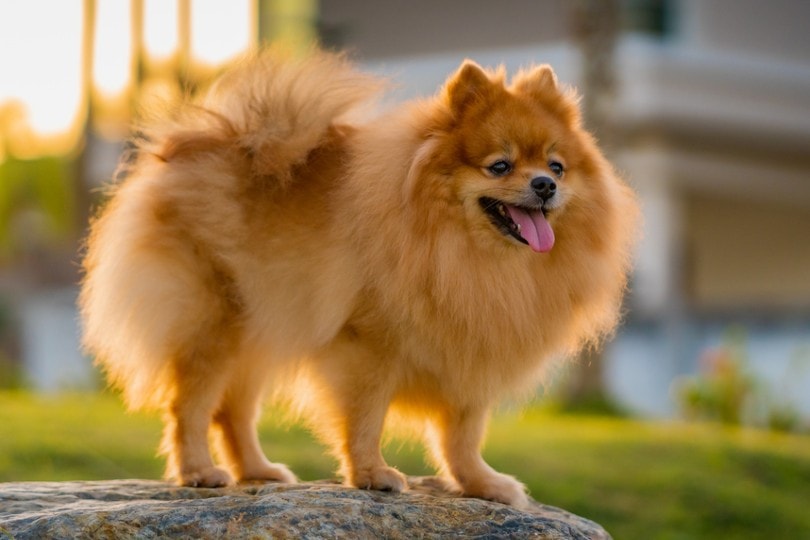Click to Skip Ahead
If you’ve ever seen a brown Pomeranian, chances are you fell madly in love with their small, charming, and delicate nature. While these gentle dogs have a fluffy, chocolate appearance, you should never underestimate their somewhat fiery personalities. They are known for their sassy temper, which makes them even more adorable to people.
Many factors make brown Pomeranians a charming breed, along with their unique history. If you’d like to learn more exciting information about brown Pomeranians, read on below!
Breed Overview
Height:
6–7 inches
Weight:
3–7 pounds
Lifespan:
12–16 years
Colors:
Black, blue, brown (chocolate), brindle, beaver, sable, cream, orange, red, white, tri-colored, particolored
Suitable for:
Active families with children, seniors
Temperament:
Intelligent, energetic, outgoing, protective, loving, and affectionate
Pomeranians can come in various sizes, colors, and shades. Some examples of Pomeranians exhibit color patterns with two or three different shades, which makes them rare, but still recognized as the breed standard. Their ideal weight is between 3 to 7 pounds, while show dogs can even vary between 4 and 6 pounds. They come in dozens of color patterns and markings that can be merle, brindle, piebald, Irish, parti, and sable. They have a double coat, with an inner and outer layer that protects the skin.
Pomeranian Breed Characteristics
The Earliest Records of Pomeranians in History
While they look incredibly interesting, you may wonder about the Pomeranian dog’s history and origin. These pups have a unique story, which began in an area that bordered Germany and Poland—Pomerania. This region runs across the coast of the Baltic Sea, and the name Pomerania comes from the word pommore, which means “on the sea”.
The Pomeranian originally descended from the Spitz sled dogs in the frozen Arctic region of Iceland. The Spitz was transported to Europe, where it was bred for different purposes. In Italy, it was used as a guard dog, while the Germans claimed it to be a national German breed and referred to the Pomeranian as the German Spitz.

How Pomeranians Gained Popularity
Pomeranians began gaining popularity in Europe when English royalty became interested in this breed. The course of history took Pomeranians into England when Queen Victoria visited Italy and fell in love with the breed. Queen Victoria became a serious Pomeranian breeder and began taking her dogs to exhibits and dog shows. Queen Victoria also made toy Pomeranians gain popularity as their original 30-pound weight was drastically reduced to a smaller size.
The brown or chocolate Pomeranian was one of the original Pomeranian breed colors. Most champions at the beginning of Pomeranian history had a beautiful chocolate coat. The brown Pomeranian continues to surge in popularity, especially in dog shows and exhibits. The global interest in pure chocolate Pomeranians grows, and they continue to take Championship titles from other Pomeranian breed colors.
Formal Recognition of Pomeranians
Pomeranians were formally recognized in 1888 by the American Kennel Club1. The standards also recognize the brown Pomeranian as one of the many official colors of the Pomeranian. In 1900, the American Pomeranian Club was formed as an official club member of the American Kennel Club. The American Pomeranian Club was designated as a parent club for this breed in 1909.

Top 3 Unique Facts About Brown Pomeranians

1. They are Highly Intelligent
Because Pomeranians are so intelligent and energetic, they require daily mental and physical activity and are excellent as therapy dogs.
2. They Have a Double Coat
Pomeranians have a double coat, where the inner coat is an insulator responsible for supporting the longer outer coat, and the outer coat shields the skin from the sun and weather.
3. The Sun Can Affect Their Coat Coloring
Brown Pomeranian owners who want to do well in shows need to keep their dogs away from the sun as it can cause reddish shading on their chocolate coats.

Do Brown Pomeranians Make Good Pets?
Brown Pomeranians are absolutely stunning to the eye and incredibly sweet and affectionate as pets. They are perfect for smaller living areas such as apartments or smaller houses. Pomeranians are attentive dogs that are easy to teach and train, making them ideal for indoor life. They can live in the city and the suburbs and will make excellent companions for your children. They will make a perfect relaxing buddy but will also happily accompany you on daily walks.
There are many benefits to having a brown Pomeranian as a pet, although when not trained and socialized properly, they can exhibit sassy behavior toward other dogs. Also, their dense coat requires regular grooming.


Conclusion
Pomeranians are one of the most popular dog breeds in the world, with a “royal” background that accentuates their elegant appearance. Their chocolate or brown coat is officially recognized by the American Kennel Club, and there are plenty more interesting colors this breed can exhibit. Brown Pomeranians are amazing pets that will fill your every day with much joy and energy.
Featured Image Credit: Kongrat, Shutterstock











